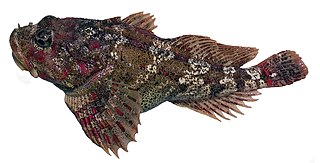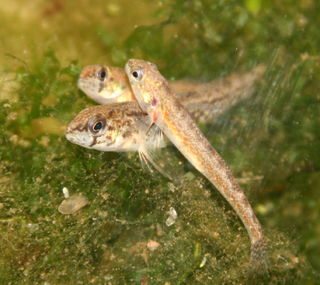
The twohorn sculpin is an Arctic benthic fish species of the order Scorpaeniformes.

The coral catshark is a species of catshark in the family Scyliorhinidae. It is common on shallow coral reefs across the Indo-West Pacific, from Pakistan to New Guinea. Reaching up to 70 cm (28 in) in length, the coral catshark has an extremely slender body, a short head and tail, and two dorsal fins that are angled backwards. It can be identified by the numerous black and white spots on its back, sides, and fins, which often merge to form horizontal bars. Furthermore, adult males have distinctively long and thin claspers.

Synodontis nigrita, known as the false upside down catfish, is a species of upside-down catfish that occurs widely in northern Africa. It was first described by French zoologist Achille Valenciennes in 1840. The type specimen is in the Muséum National d' Histoire Naturelle de Paris.
Zaireichthys is a genus of loach catfishes of the family Amphiliidae.

Synodontis petricola, known as the cuckoo catfish, or the pygmy leopard catfish, is a species of upside-down catfish endemic to Burundi, Zambia, the Democratic Republic of the Congo, and Tanzania where it is only known from Lake Tanganyika. It was first described by Belgian ichthyologist Hubert Matthes in 1959. The species name "petricola" is derived from a combination of the Latin petra, meaning stone or rock, and the Latin cola, meaning inhabitant. This refers to the rocky environment where this species is found.
Zaireichthys heterurus is a species of loach catfish endemic to the Democratic Republic of the Congo where it is found in the Lualaba River. It reaches a length of 3.5 cm and has a broad, black collar just behind the head. The barbels are attenuate, with the maxillary barbels extending posteriorly to middle to end of the pectoral fin spine and the caudal peduncle is slender. The humeral process of the pectoral girdle is long and stout without denticulations. The caudal fin is deeply forked, with the upper lobe much shorter and smaller than the lower lobe; also, the fin rays in lower lobe noticeable thicker than those in upper lobe.
Zaireichthys mandevillei is a species of loach catfish found in the Central African Republic and the Democratic Republic of the Congo where it is found in the Congo River Basin. It grows to a length of 2.6 cm and has a broad, black collar just behind the head and a spotted colour pattern. The barbels are attenuate, with the maxillary barbels extending posteriorly to middle to end of the pectoral fin spine and the caudal peduncle is slender. The humeral process of the pectoral girdle is short and without denticulations. The caudal fin is deeply forked, with the upper lobe much shorter and smaller than the lower lobe; also, the fin rays in lower lobe noticeable thicker than those in upper lobe.

Synodontis grandiops is a species of upside-down catfish endemic to the Democratic Republic of the Congo, Burundi, and Tanzania, where it is only known from Lake Tanganyika. It was first described by Jeremy John Wright and Lawrence M. Page in 2006, from specimens collected at multiple points along the shore of Lake Tanganyika. The species name is a Latinized combination of the Latin "grandi", meaning large or big, and the Greek "ops", meaning eye, a reference to the relatively large eyes of this fish.
Synodontis ilebrevis is a species of upside-down catfish endemic to Zambia, where it is only known from Lake Tanganyika. It was first described by Jeremy John Wright and Lawrence M. Page in 2006, from specimens collected from Lake Tanganyika at Cape Chaitika, Zambia. The species name comes from the Latin word "ile", meaning intestine, and the Latin word "bevis", meaning short, and refers to the relatively short gut of this species.

Synodontis macrostigma, known as the largespot squeaker, is a species of upside-down catfish that is native to Angola, Botswana, Namibia, South Africa and Zambia where it is found in the Cunene, Okavango, upper Zambezi and Kafue River systems. It was first described by British-Belgian zoologist George Albert Boulenger in 1911, from specimens collected in the Okovango River, Botswana, by R. B. Woosnam. The species name macrostigma is derived from the Greek word makros, meaning "large", and the Greek word stigma, meaning "mark" or "spot" and refers to the large spots on the sides of the fish.

Synodontis multimaculatus, known as the dotted synodontis, is a species of upside-down catfish that is native to the Democratic Republic of the Congo where it is found in the Ubangi River. It was first described by British-Belgian zoologist George Albert Boulenger in 1902, from a specimen collected in the Ubangi River in Mobayi-Mbongo, the Democratic Republic of the Congo. The species name multimaculatus is derived from the word multi, meaning many, and the Latin word maculatus, meaning spots, referring to the many spots on the fish.

Synodontis nebulosus, known as the cloudy squeaker, or clouded squeaker, is a species of upside-down catfish that is native to the lower Zambezi River basin of Malawi, Mozambique, Zambia and Zimbabwe. It was first described by German naturalist and explorer Wilhelm Peters in 1852, from a specimen collected in the Zambezi River at Tete, Mozambique. The species name nebulosus is derived from the Latin word nebulosus, meaning "foggy", "cloudy", or "full of mist".

Synodontis obesus, known as the Coas synodontis, is a species of upside-down catfish that is native to the coastal drainages of Cameroon, Ghana, Nigeria and Togo. It was first described by British-Belgian zoologist George Albert Boulenger in 1898. The species name obesus is derived from the Latin word obesus, meaning "fat".

Synodontis omias is a species of upside-down catfish native to the Niger River basin of Guinea, Mali, Niger and Nigeria. It was first described by German-born British zoologist, ichthyologist, and herpetologist Albert Günther in 1864, from a specimen collected in Jebba, Nigeria, on the Niger River. There have been very few specimens of this species identified, and it may be the same species as S. budgetti from the Upper Niger.

Synodontis pardalis is a species of upside-down catfish that is endemic to Cameroon where it occurs in the Dja River drainage. It was first described by British-Belgian zoologist George Albert Boulenger in 1908, from specimens collected in the Dja River in southern Cameroon. The species name pardalis is derived from the Greek word pardalis, which means "leopard", which refers to the spotted pattern on the fish.
Synodontis tanganyicae is a species of upside-down catfish endemic to the Democratic Republic of the Congo, Zambia, and Tanzania, where it is only known from Lake Tanganyika. It was first described by Russian-American ichthyologist Nikolai Andreyevich Borodin in 1936, from specimens collected at Kasaga, in what is now the Democratic Republic of the Congo. The species name tanganyicae comes from the habitat of the species, Lake Tanganyika.
Synodontis lucipinnis is a species of upside-down catfish endemic to Zambia, where it is only known from the Musende Rocks area (Mpulungu) of Lake Tanganyika. It was first described by Jeremy John Wright and Lawrence M. Page in 2006. The species name "lucipinnis" is derived from a combination of the Latin luci, meaning bright or clear, and the Latin pinnis, meaning fin. This refers to the light coloration in a patch on the base of the fins of this species.

Etheostoma exile, the Iowa darter, is a species of freshwater ray-finned fish, a darter from the subfamily Etheostomatinae, part of the family Percidae, which also contains the perches, ruffes and pikeperches. It is, along with about 17 other species of darters, is native to the lakes and streams of Iowa.

Synodontis melanostictus is a species of upside-down catfish endemic to Lake Tanganyika and its tributaries. It has been found in Zambia, the Democratic Republic of the Congo, and Burundi. It was first described by British-Belgian zoologist George Albert Boulenger in 1906, based upon a specimen from the Lofubu River. The species name "melanostictus" is derived from a combination of the Greek melano, meaning black, and the Greek stiktos, meaning punctured or spotted. This refers to the black spotted pattern that occurs on the body of this species.
Synodontis irsacae is a species of upside-down catfish endemic to Zambia, the Democratic Republic of the Congo, and Tanzania, where it is only known from Lake Tanganyika. It was first described by Belgian ichthyologist Hubert Matthes in 1959, from specimens collected from Lake Tanganyika at Kalundu, in what is now the Democratic Republic of the Congo. The species name " irsacae" is derived from the abbreviation "I.R.S.A.C.", or Institut pour la Recherche Scientifique en Afrique Centrale. For many years, specimens of the species were considered to be juvenile members of S. dhonti, but in 2006, J.J. Wright and L.M. Page identified unique characteristics of this species that established that they were a unique species.













